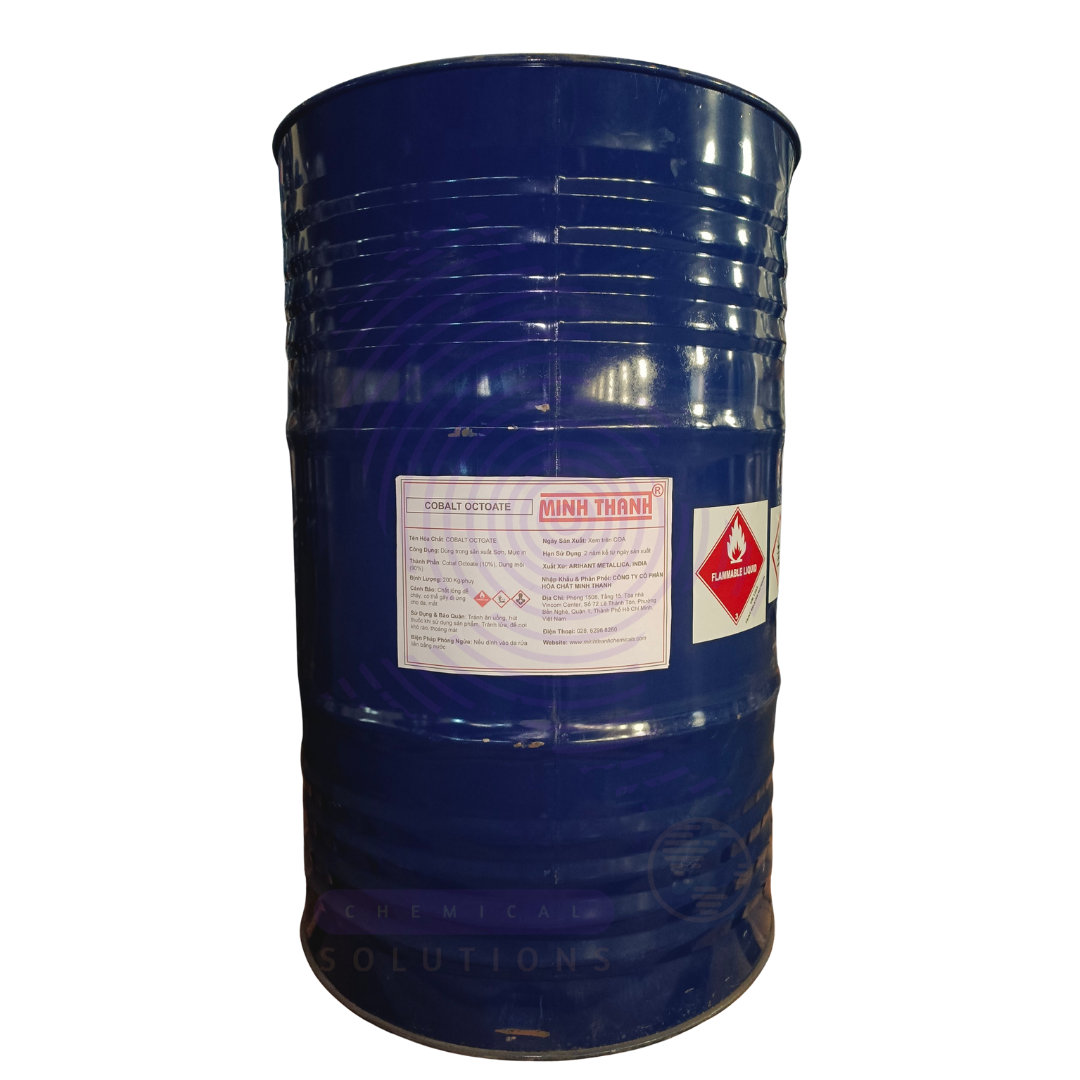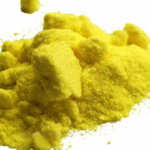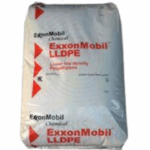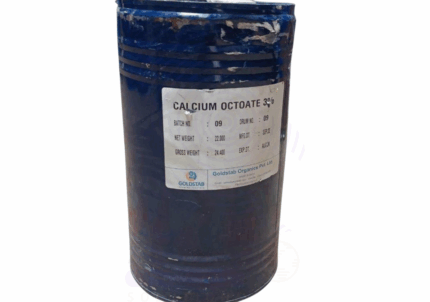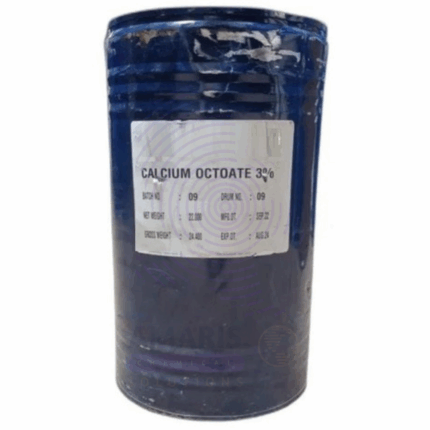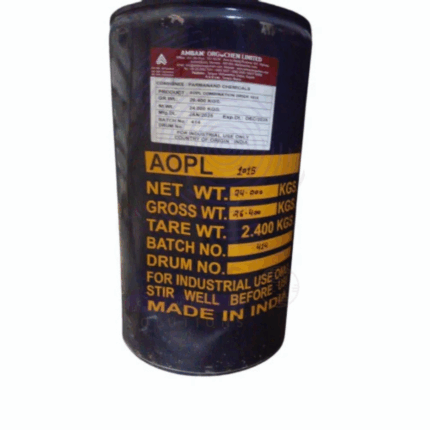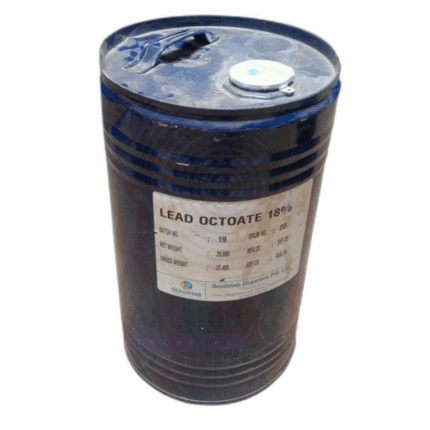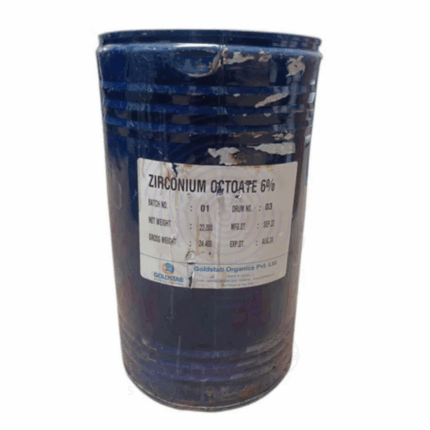Cobalt Octoate
Cobalt Octoate is a liquid metal drying agent solution consisting of 10% cobalt octoate dissolved in an organic solvent carrier (typically mineral spirits or similar hydrocarbon solvent). It functions as a highly efficient catalyst to accelerate the oxidative curing and drying of alkyd resins, oils, and varnishes in coatings and paints. By promoting cross-linking and polymerization of unsaturated fatty acids in drying oils upon exposure to oxygen, it significantly reduces drying time and enhances film hardness, gloss, and durability. Cobalt Octoate 10% is widely used in industrial and decorative coatings, inks, and adhesives, valued for its strong catalytic activity even at low concentrations.
Cobalt Octoate
Primary Uses
- Paints, Coatings & Varnishes
- Used as a drying catalyst in oil-based paints, alkyd resin paints, enamels, varnishes, and lacquers.
- Accelerates oxidative drying of drying oils such as linseed oil, tung oil, and soya oil.
- Enhances drying speed, film hardness, gloss, and chemical resistance of coatings.
- Enables faster production and handling times in industrial and commercial painting applications.
- Printing Inks
- Incorporated in oxidative drying printing inks to improve drying rate and tack-free time on substrates like paper, metal, and plastic.
- Enhances adhesion and surface finish quality.
- Adhesives & Sealants
- Used in formulations where drying and curing of unsaturated oil-based resins or adhesives is required.
- Improves set times and bonding durability.
Secondary Uses
- Wood Finishing
- Added to wood stains, oils, and lacquers to accelerate drying and improve surface hardness and protection.
- Artistic Oil Paint Mediums
- Employed in oil painting mediums by artists to reduce drying time without compromising finish or color integrity.
- Polymer & Resin Chemistry
- Acts as a catalyst in cross-linking reactions of certain resins beyond traditional coatings.
- Metal Treatments
- Used in specialty protective metal coatings and drying formulations to promote faster curing.
1. Basic Identification Attributes
- Chemical Name (IUPAC): Cobalt(II) 2-ethylhexanoate (solution)
- Common/Trade Name: Cobalt Octoate 10%
- CAS Number: 136-52-7 (for pure cobalt octoate)
- HS Code: 2915.70.00
- Molecular Formula: Variable (complex cobalt salt solution)
- Synonyms:
- Cobalt 2-ethylhexanoate
- Cobalt octanoate solution
2. Physical & Chemical Properties
- Physical State: Liquid solution
- Color & Odor: Amber to reddish-brown; characteristic solvent odor
- Melting/Freezing Point: Not applicable (liquid)
- Boiling Point: Approx. 230–270°C (dependent on solvent)
- Density: ~1.0–1.1 g/cm³
- Solubility:
- Soluble in organic solvents such as mineral spirits, aromatic hydrocarbons, ketones
- Insoluble in water
- Stability: Stable under normal conditions; sensitive to strong acids and bases
3. Safety & Hazard Attributes
- Hazard Class (GHS):
- Harmful if swallowed or inhaled
- Skin and respiratory sensitizer
- May cause allergic skin reactions
- Toxic to aquatic life with long-lasting effects
- NFPA Ratings:
- Health: 2
- Flammability: 2
- Reactivity: 0
- Exposure Limits: No specific OSHA PEL; cobalt compounds generally limited to 0.1 mg/m³ (TWA)
- Toxicity: May cause skin and respiratory sensitization; chronic exposure can lead to lung effects and cobalt-related health risks
- Reactivity: Stable; avoid contact with strong oxidizers and acids
4. Storage & Handling Attributes
- Storage Conditions: Store in tightly sealed containers in a cool, dry, well-ventilated area away from heat, sparks, and ignition sources
- Container Type: Metal or plastic drums with secure seals
- Shelf Life: Typically 1–2 years if stored properly
- Special Handling:
- Use explosion-proof equipment and grounding to prevent static discharge
- Avoid skin and eye contact; ensure adequate ventilation
5. Regulatory & Compliance Attributes
- FDA Status: Not approved for food or pharmaceutical use
- REACH Status: Registered as a cobalt compound under EU chemical safety regulations
- Transportation: Classified as flammable liquid (due to solvent content) and hazardous material for transport
- Waste Disposal: Dispose of as hazardous waste according to local regulations
6. Environmental & Health Impact
- Ecotoxicity: Toxic to aquatic organisms; avoid environmental release
- Persistence: May persist in soils and sediments due to cobalt content
- Bioaccumulation: Low potential
- Carcinogenicity/Mutagenicity: Cobalt compounds classified as possible carcinogens (IARC Group 2B)
- Biodegradability: Organic solvents biodegradable; cobalt metal is elemental and persistent
Safety Handling Precautions
Personal Protective Equipment (PPE):
- Chemical-resistant gloves
- Safety goggles or face shield
- Respirator if ventilation is insufficient
- Protective clothing
Handling Measures:
- Avoid inhalation and skin contact
- Use in well-ventilated areas or fume hoods
- Prevent environmental release
Storage Measures:
- Store away from heat, sparks, and open flames
- Keep container tightly closed
- Ground and bond containers during transfer
Hygiene Practices:
- Wash hands thoroughly after handling
- Do not eat, drink, or smoke in handling areas
First Aid Measures
- Inhalation: Move to fresh air; if breathing is difficult, provide oxygen and seek medical attention
- Skin Contact: Wash with soap and water; seek medical advice if irritation or allergy develops
- Eye Contact: Rinse with plenty of water for 15 minutes; seek medical care if irritation persists
- Ingestion: Do not induce vomiting; seek emergency medical assistance immediately
Firefighting Measures
- Fire Hazards: Flammable due to organic solvent carrier; cobalt salts themselves are not combustible
- Extinguishing Media: Foam, dry chemical, carbon dioxide (CO₂)
- Special Precautions: Firefighters should wear full protective gear and self-contained breathing apparatus
- Decomposition Products: May release cobalt oxides, carbon monoxide, carbon dioxide, and solvent vapors upon burning


 Preservatives(food)
Preservatives(food) Flavor Enhancers
Flavor Enhancers Acidulants
Acidulants Sweeteners
Sweeteners Antioxidants
Antioxidants Colorants(food)
Colorants(food) Nutraceutical Ingredients (food)
Nutraceutical Ingredients (food) Nutrient Supplements
Nutrient Supplements Emulsifiers
Emulsifiers
 Collectors
Collectors Dust Suppressants
Dust Suppressants Explosives and Blasting Agents
Explosives and Blasting Agents Flocculants and Coagulants
Flocculants and Coagulants Frothers
Frothers Leaching Agents
Leaching Agents pH Modifiers
pH Modifiers Precious Metal Extraction Agents
Precious Metal Extraction Agents
 Antioxidants(plastic)
Antioxidants(plastic) Colorants (Pigments, Dyes)
Colorants (Pigments, Dyes) Fillers and Reinforcements
Fillers and Reinforcements Flame Retardants
Flame Retardants Monomers
Monomers Plasticizers
Plasticizers Polymerization Initiators
Polymerization Initiators Stabilizers (UV, Heat)
Stabilizers (UV, Heat)
 Antifoaming Agents
Antifoaming Agents Chelating Agents
Chelating Agents Coagulants and Flocculants
Coagulants and Flocculants Corrosion Inhibitors
Corrosion Inhibitors Disinfectants and Biocides
Disinfectants and Biocides Oxidizing Agents
Oxidizing Agents pH Adjusters
pH Adjusters Scale Inhibitors( water)
Scale Inhibitors( water)
 Antioxidants(cosmetic)
Antioxidants(cosmetic) Emollients
Emollients Fragrances and Essential Oils
Fragrances and Essential Oils Humectants
Humectants Preservatives
Preservatives Surfactants(cosmetic)
Surfactants(cosmetic) Thickeners
Thickeners UV Filters
UV Filters
 Fertilizers
Fertilizers Soil Conditioners
Soil Conditioners Plant Growth Regulators
Plant Growth Regulators Animal Feed Additives
Animal Feed Additives Biostimulants
Biostimulants Pesticides (Herbicides, Insecticides, Fungicides)
Pesticides (Herbicides, Insecticides, Fungicides)
 Active Pharmaceutical Ingredients (APIs)
Active Pharmaceutical Ingredients (APIs) Excipients
Excipients Solvents(pharmaceutical)
Solvents(pharmaceutical) Antibiotics
Antibiotics Antiseptics and Disinfectants
Antiseptics and Disinfectants Vaccine Adjuvants
Vaccine Adjuvants Nutraceutical Ingredients (pharmaceutical)
Nutraceutical Ingredients (pharmaceutical) Analgesics & Antipyretics
Analgesics & Antipyretics
 Analytical Reagents
Analytical Reagents Solvents(lab)
Solvents(lab) Chromatography Chemicals
Chromatography Chemicals Spectroscopy Reagents
Spectroscopy Reagents microbiology-and-cell-culture-reagents
microbiology-and-cell-culture-reagents Molecular Biology Reagents
Molecular Biology Reagents Biochemical Reagents
Biochemical Reagents Inorganic and Organic Standards
Inorganic and Organic Standards Laboratory Safety Chemicals
Laboratory Safety Chemicals Specialty Laboratory Chemicals(Special Laboratory Equipment)
Specialty Laboratory Chemicals(Special Laboratory Equipment)
 Demulsifiers
Demulsifiers Hydraulic Fracturing Fluids
Hydraulic Fracturing Fluids Scale Inhibitors(oil)
Scale Inhibitors(oil) Surfactants(oil)
Surfactants(oil) Drilling Fluids
Drilling Fluids
 Dyes and Pigments
Dyes and Pigments Bleaching Agents
Bleaching Agents Softening Agents
Softening Agents Finishing Agents
Finishing Agents Antistatic Agents
Antistatic Agents
 Admixtures
Admixtures Waterproofing Agents
Waterproofing Agents Sealants and Adhesives
Sealants and Adhesives Curing Compounds
Curing Compounds Concrete Repair Chemicals
Concrete Repair Chemicals Anti-Corrosion Coatings
Anti-Corrosion Coatings
 Surfactants(cleaning)
Surfactants(cleaning) Builders
Builders Enzymes
Enzymes Solvents (Cleaning)
Solvents (Cleaning) Fragrances
Fragrances
 Electronic Chemicals
Electronic Chemicals Catalysts
Catalysts Lubricants
Lubricants Photographic Chemicals
Photographic Chemicals Refrigerants
Refrigerants Automotive chemicals
Automotive chemicals Pyrotechnic Chemicals
Pyrotechnic Chemicals
 Biodegradable Surfactants
Biodegradable Surfactants Bio-based Solvents
Bio-based Solvents Renewable Polymers
Renewable Polymers Carbon Capture Chemicals
Carbon Capture Chemicals Wastewater Treatment Chemicals
Wastewater Treatment Chemicals
 Pigments
Pigments Solvents(paint)
Solvents(paint) Specialty Coatings
Specialty Coatings Binders/Resins
Binders/Resins Additives
Additives Driers
Driers Anti-Corrosion Agents
Anti-Corrosion Agents Functional Coatings
Functional Coatings Application-Specific Coatings
Application-Specific Coatings
 Fresh Herbs
Fresh Herbs Ground Spices
Ground Spices Whole Spices
Whole Spices Spice Blends
Spice Blends Dried Herbs
Dried Herbs
 Leavening Agents
Leavening Agents Dough Conditioners
Dough Conditioners Flour Treatments
Flour Treatments Fat Replacers
Fat Replacers Decoratives
Decoratives Preservatives(baking)
Preservatives(baking)
 Plasticizers & Softeners
Plasticizers & Softeners Reinforcing Agents
Reinforcing Agents Adhesion Promoters
Adhesion Promoters Vulcanizing Agents
Vulcanizing Agents Antidegradants
Antidegradants Blowing Agents
Blowing Agents Fillers & Extenders
Fillers & Extenders Accelerators & Retarders
Accelerators & Retarders